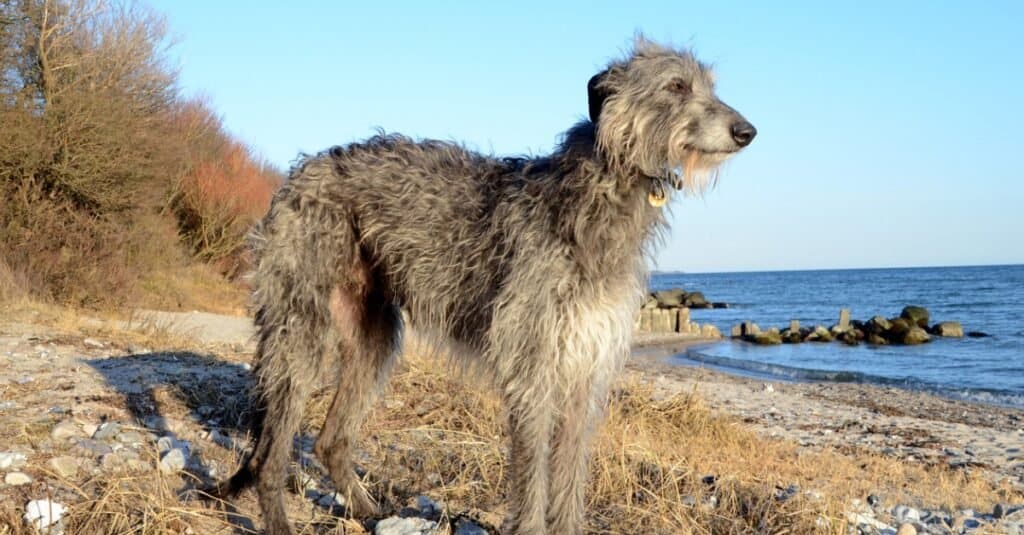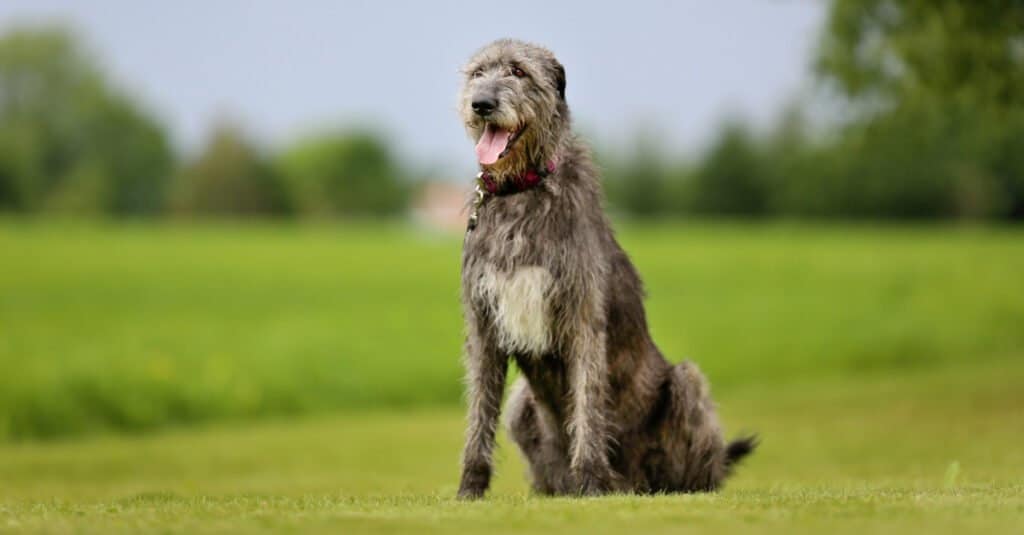Irish Wolfhounds are the tallest among all the American Kennel Club breeds. These giant dogs were used in 15th-century Ireland to hunt wolves. With their muscular build, they made intimidating opponents. However, today, they are much-loved family pets with their calm and gentle temperaments. They come in various colors, including black, red, gray, white, and fawn. This article will examine the Irish Wolfhound progression and what you can expect when owning one of these gorgeous dogs.
Breed Summary
Irish Wolfhounds are known as one of the tallest dog breeds. Also, they have wiry, shaggy coats with long hair over their nose and eyes and under their jaws. They come in various colors, like fawn, black, gray, white, and brindle. These dogs have big dark eyes and undocked, curved tails. Additionally, they are between 30 to 33 inches tall and can weigh between 105 to 140 pounds. Irish Wolfhounds are known for being gentle yet strong and fast as they are hunting dogs.

Irish Wolfhounds are known as one of the tallest dog breeds. Also, they have wiry, shaggy coats with long hair over their nose and eyes and under their jaws.
©iStock.com/nemoris
Irish Wolfhound Growth and Weight Chart by Age
As with all dog breeds, dogs grow and progress at different rates. The table below estimates what these dogs should weigh at certain ages. If you are an Irish Wolfhound owner and your dog is not progressing according to the estimates, it is a good idea to take them to the vet for a check-up.
| Age | Female Weight | Male Weight |
|---|---|---|
| 1 month | 5 – 10 lbs | 5 – 10 lbs |
| 2 months | 15 – 30 lbs | 20 – 35 lbs |
| 3 months | 25 – 45 lbs | 35 – 55 lbs |
| 4 months | 30 – 50 lbs | 40 – 60 lbs |
| 5 months | 40 – 60 lbs | 50 – 70 lbs |
| 6 months | 50 – 70 lbs | 60 – 80 lbs |
| 7 months | 55 – 75 lbs | 70 – 90 lbs |
| 8 months | 60 – 80 lbs | 75 – 95 lbs |
| 9 months | 65 – 85 lbs | 80 – 100 lbs |
| 10 months | 70 – 90 lbs | 90 – 110 lbs |
| 11 months | 75 – 95 lbs | 95 – 115 lbs |
| 12 months | 80 – 100 lbs | 100 – 120 lbs |
| 24 months | 90 – 120 lbs | 110 – 140 lbs |
When Will My Irish Wolfhound Stop Growing?
Irish Wolfhounds are considered a giant dog breed. Therefore, they take longer to mature and develop than small or medium-sized dogs. These dogs will only mature or stop growing at the age of two. Furthermore, to keep them healthy and developing correctly, these dogs should be fed good quality dog food and be taken to the vet for regular check-ups. It is recommended to take your dog to the vet once a year. When it comes to feeding, they should be fed twice a day. However, because of their long legs, it is advised to use a raised feeding platform.
How Big Will My Irish Wolfhound Be When It’s Fully Grown?
Irish Wolfhounds can weigh up to 180 pounds and stand 3 feet tall. Therefore, they are known as a giant dog breed. There are a few ways to estimate the size of an Irish Wolfhound, such as gender, paw size, and parents. Also, factors such as the breeder they came from and how they are cared for could affect how big they become.
The Biggest Irish Wolfhound Ever Recorded
An Irish Wolfhound in Westerlo, Belgium, enjoys the Guinness World record for the dog with the longest tail. Keon, the Irish Wolfhound, has a tail that measures 30.2 inches. Impressive, as it is 1.7 inches longer than the previous record.
When Should My Irish Wolfhound Be Spayed or Neutered?
There is little evidence that spaying or neutering your Irish Wolfhound will influence their health. However, many believe it improves their quality of life and can help deter certain types of cancer and aggressive behavior in males. The recommendation for when to neuter an Irish Wolfhound is between 6 and 12 months. When it comes to females, you can wait until they are one year old, as it is advised to wait for them to come into season at about seven to nine months old first. Every dog is different, though; your vet can guide you when the right time will be.
When Should My Irish Wolfhound Be House Broken?
These intelligent dogs can be trained at any age. However, the best age to start house training is between 8 to 12 weeks. Crate training is a great way to go, as they will not want to mess in their space and will soon realize that they need to go outside when they get the chance. Also, keeping cleaning materials nearby would be a good idea until you are confident your pup is fully housebroken. It takes patience and consistency, but taking your dog outside at least every hour and straight after meals will pay off. There are also signs to look out for, such as sniffing and squatting.
When Should My Irish Wolfhound Stop Eating Puppy Food?
Irish Wolfhound progression is slower as they are a giant dog breed. Therefore, when they are puppies, they should be fed at least three meals a day. As with all dogs, their needs change as they progress, and they have different needs at different stages of their lives. When they reach one year old, it is recommended to stop feeding them puppy food. The new trend is to feed your dog a raw diet, which is said to have many health benefits.
When Will My Irish Wolfhound Start Losing Teeth?
Puppy teeth start to grow between two to four weeks, and they should have all their puppy teeth by five to six weeks old. Then, when they reach six months old, they start teething. Puppies will begin losing their puppy teeth at about 12 weeks old for a few months until all the adult teeth have come in. Some teething symptoms include missing teeth, drooling excessively, chewing on everything, poor appetite, and swollen or bleeding gums. It would be a good idea to have lots of toys your puppy can chew when they are teething. Some must-have toys include a Kong, balls, and tug toys. Lastly, positive reinforcement is a far better way to deal with chewing than punishment.
When Should I Start Training My Irish Wolfhound?
When training an Irish Wolfhound puppy, the sooner you start, the better. Training can begin as early as seven weeks. Start teaching the puppy where their food and water is, where their bed is, what time they should go to bed, when they should go outside, and where they will be groomed. Consistency is vital, and daily routines should remain unchanged as far as possible.
What Cues Should I Teach My Irish Wolfhound First?
Training should be gradual, and after establishing a routine, you can start teaching your puppy specific cues. Positive reinforcement works wonders when training, such as rewarding your pup with a treat when they do what you want. Therefore, it is advisable to keep treats on hand.
The first two cues you can teach an Irish Wolfhound are “No” and “Yes.” You can do this by stopping the puppy when they are doing something you don’t want it to do and rewarding it or giving attention when it does something acceptable. After that, you can move on to commands like “sit” by trailing a treat down the back of their head, forcing them to tilt their head back and eventually sit. When they have mastered “sit,” you can move on to “stay” and more complex cues.
When Will My Irish Wolfhound Calm Down?
Irish Wolfhounds generally calm down when they reach the age of two. However, this will differ from dog to dog and depends on training, lifestyle, and exercise. Also, socialization and training are essential and should be consistent throughout your dog’s life. Don’t let your dog push boundaries if possible. Irish Wolfhounds will try, especially when they are puppies. Leash training is also a significant tool, and this should be taught from when they are puppies.
Dogs should walk at the owner’s pace and not pull. An excellent way to teach this is to ensure your dog walks next to or behind you, not in front of you. Lastly, give your dog a job, such as sniffing out a hidden object. These dogs should be stimulated and exercised regularly to eliminate their energy.
Common Health Issues Your Irish Wolfhound Might Experience
Irish Wolfhounds, as a giant dog breed, have a shorter life expectancy of only seven years. They are also susceptible to a few health issues, including:
- Bone cancer (Osteosarcoma): an aggressive and malignant bone cancer. Symptoms include lameness or limping. This can be treated with surgery and chemotherapy.
- Gastric Dilation-Volvulus (GDV, Bloat): This happens when the stomach fills up with gas or food, which causes increased pressure and expansion. It is often seen in older dogs and dogs with deep chests, like the Irish Wolfhound. Symptoms include swollen abdomen, retching, collapsing, and drooling. GDV can be treated with surgery.
- Hip Dysplasia happens when the hip joint does not fit properly into the socket. This can result in pain and can lead to osteoarthritis. Vets treat this condition differently but typically recommend medication, supplements, or surgery.
- Dilated Cardiomyopathy (DCM): degeneration of the heart that leads to the heart being unable to pump blood efficiently. This condition can culminate in congestive heart failure.
- Elbow Dysplasia: Similar to hip dysplasia, the elbow joint does not fit properly into the joint.
Pictures of Irish Wolfhounds as Puppies

When training an Irish Wolfhound puppy, the sooner you start, the better.
©Jolanta Beinarovica/Shutterstock.com

Irish Wolfhound progression is slower as they are a giant dog breed. Therefore, when they are puppies, they should be fed at least three meals a day.
©undefined undefined/iStock via Getty Images
Pictures of Fully Grown Irish Wolfhound

Irish Wolfhounds generally calm down when they reach the age of two. However, this will differ from dog to dog and depends on training, lifestyle, and exercise.
©iStock.com/Bigandt_Photography

There is little evidence that spaying or neutering your Irish Wolfhound will influence their health. However, many believe it improves their quality of life and can help deter certain types of cancer and aggressive behavior in males.
©Viktoriia Bondarenko/Shutterstock.com
The photo featured at the top of this post is © iStock.com/Ashva
Thank you for reading! Have some feedback for us? Contact the AZ Animals editorial team.







